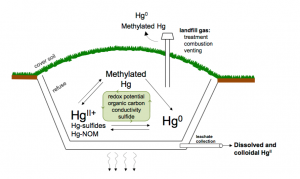The Hatter in Alice in Wonderland may not have been mad after all. He might have suffered from mercury poisoning! Thankfully, nowadays we know mercury is a dangerous element in almost all its forms. Organomercury compounds such as monomethylmercury (MMHg) and dimethylmercury (DMHg) are especially hazardous: not only because of their extreme toxicity but also because they can be bio-magnified in the food web. Moreover, mercury can travel the biosphere through air, water and soil, increasing the danger.
Even if we have stopped using mercury thermometers, a big number of household and industrial products still use this liquid metal. A lot of these products end up in landfills where they are treated as conventional waste, and may liberate dangerous amounts of this toxic metal to the atmosphere and soil.
In this critical review published in Environmental Science: Processes & Impacts, scientists analyze solid waste management in landfills and the chemistry of mercury, as well as the release of this metal into the environment and the possible bio and geological transformations it may suffer. As a conclusion, researchers review a series of studies that should be considered in depth in order to understand the problem of mercury release and to, eventually, find a solution.
 As described in this work, landfills –mainly when they undergo the so-called anaerobic phase– present the ideal conditions (pH, redox, organic matter) for mercury to be speciated and transformed, then dissolved, mobilized and disseminated within the biosphere. It is mostly released as Hg(0) in gas form, but other species like MMHg and DMHg may also be produced and incorporated to soil and water reservoirs.
As described in this work, landfills –mainly when they undergo the so-called anaerobic phase– present the ideal conditions (pH, redox, organic matter) for mercury to be speciated and transformed, then dissolved, mobilized and disseminated within the biosphere. It is mostly released as Hg(0) in gas form, but other species like MMHg and DMHg may also be produced and incorporated to soil and water reservoirs.
Whether you are a specialist in mercury or not, this review will surely captivate you. Landfills may seem boring, but the chemistry underneath is fascinating, like the liquid metal that fascinated alchemists for centuries. Remember, mercury was the prima materia from which all metals were formed!
Interested in this research? Click on the link below to read the full article for free*:
Biogeochemical transformations of mercury in solid waste landfills and pathways for release
Sung-Woo Lee, Gregory V. Lowry and Heileen Hsu-Kim.
Environmental Science: Processes & Impacts 2016, 18, 176-189
DOI: 10.139/C5EM00561B
—————-
Fernando Gomollón-Bel is a PhD Student at the ISQCH (CSIC–University of Zaragoza). His research focuses on asymmetric organic synthesis using sugars as chiral-pool starting materials towards the production of fungical transglycosidase inhibitors.
—————-
* Access is free until 18/03/2016 through a registered RSC account.












